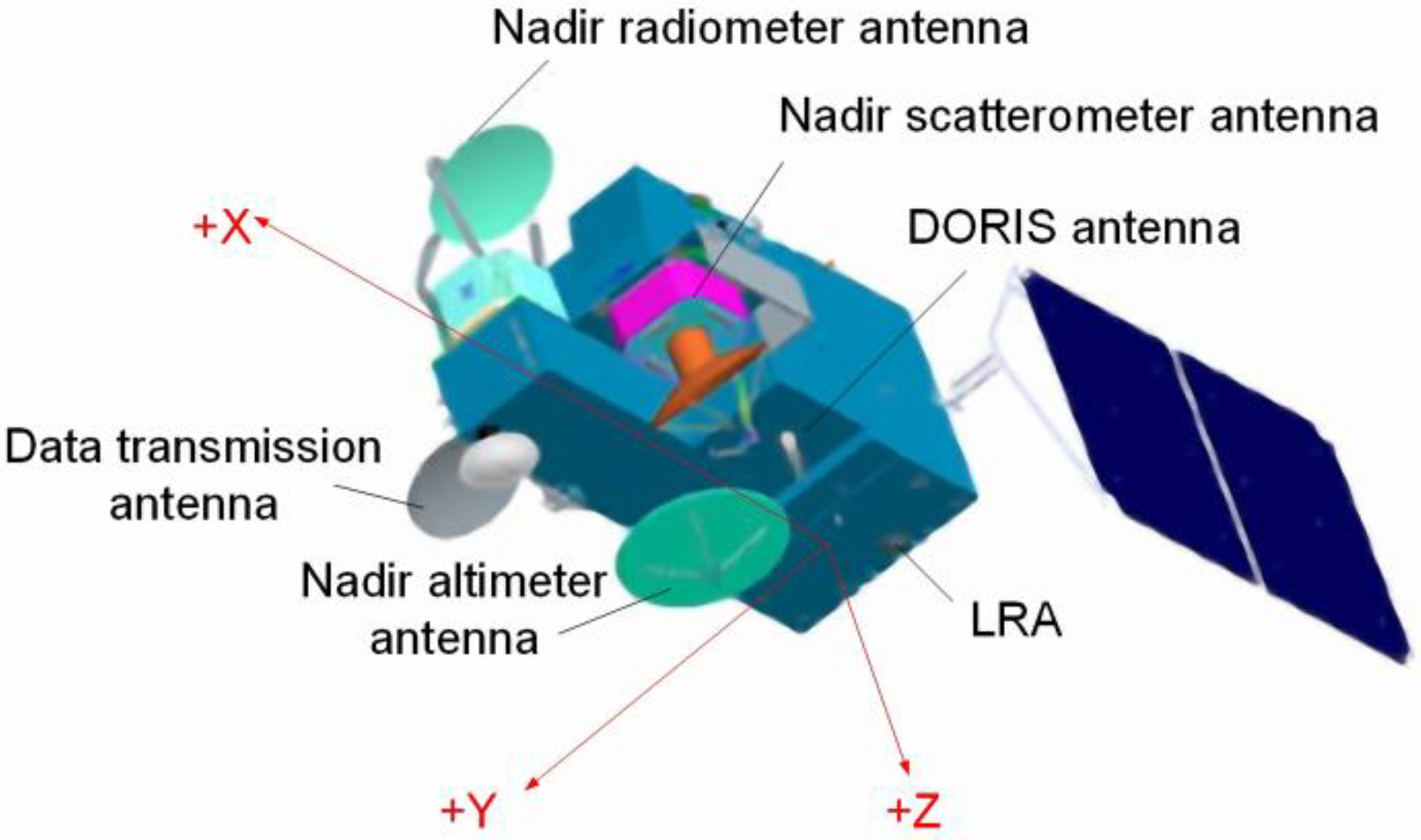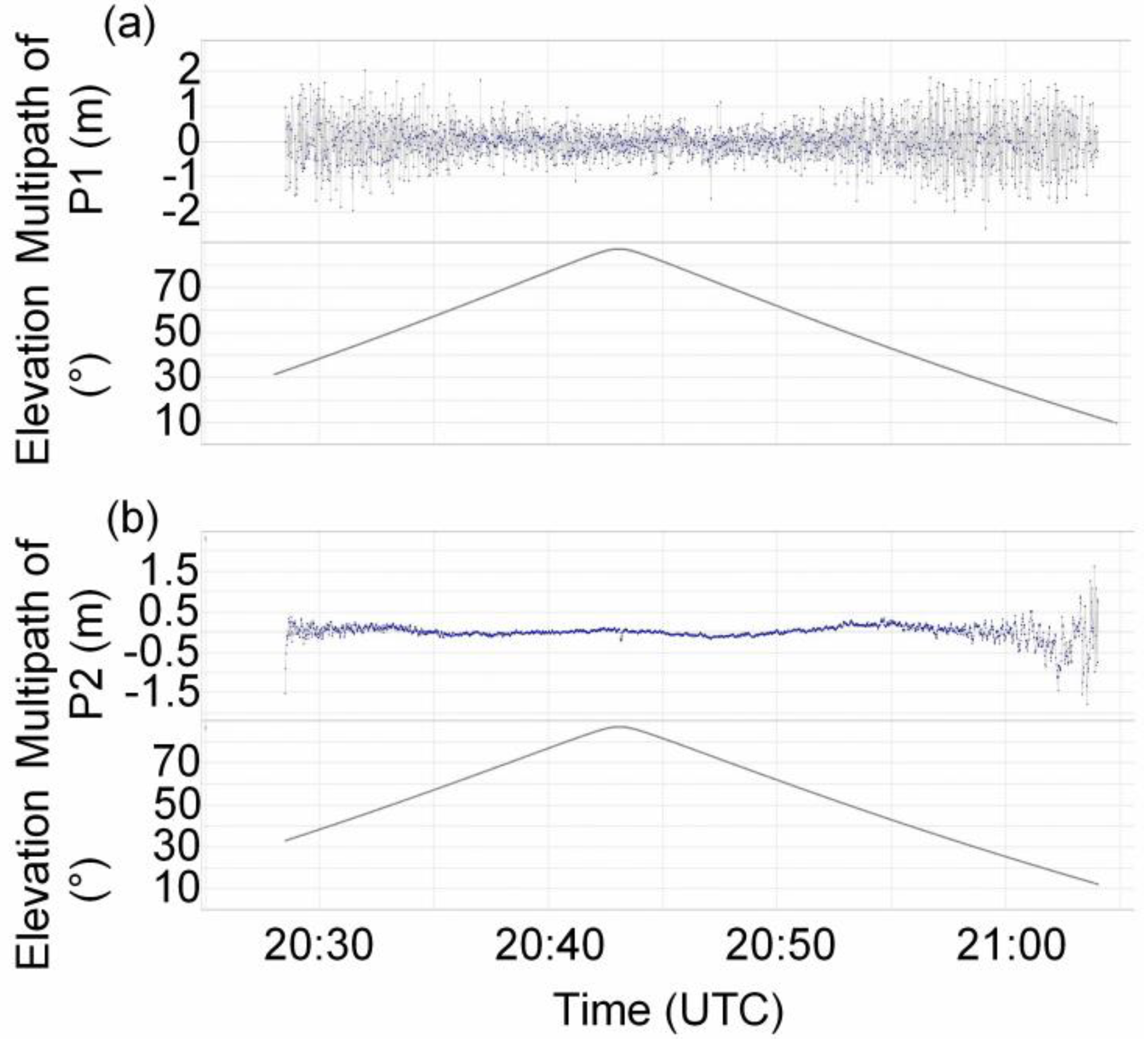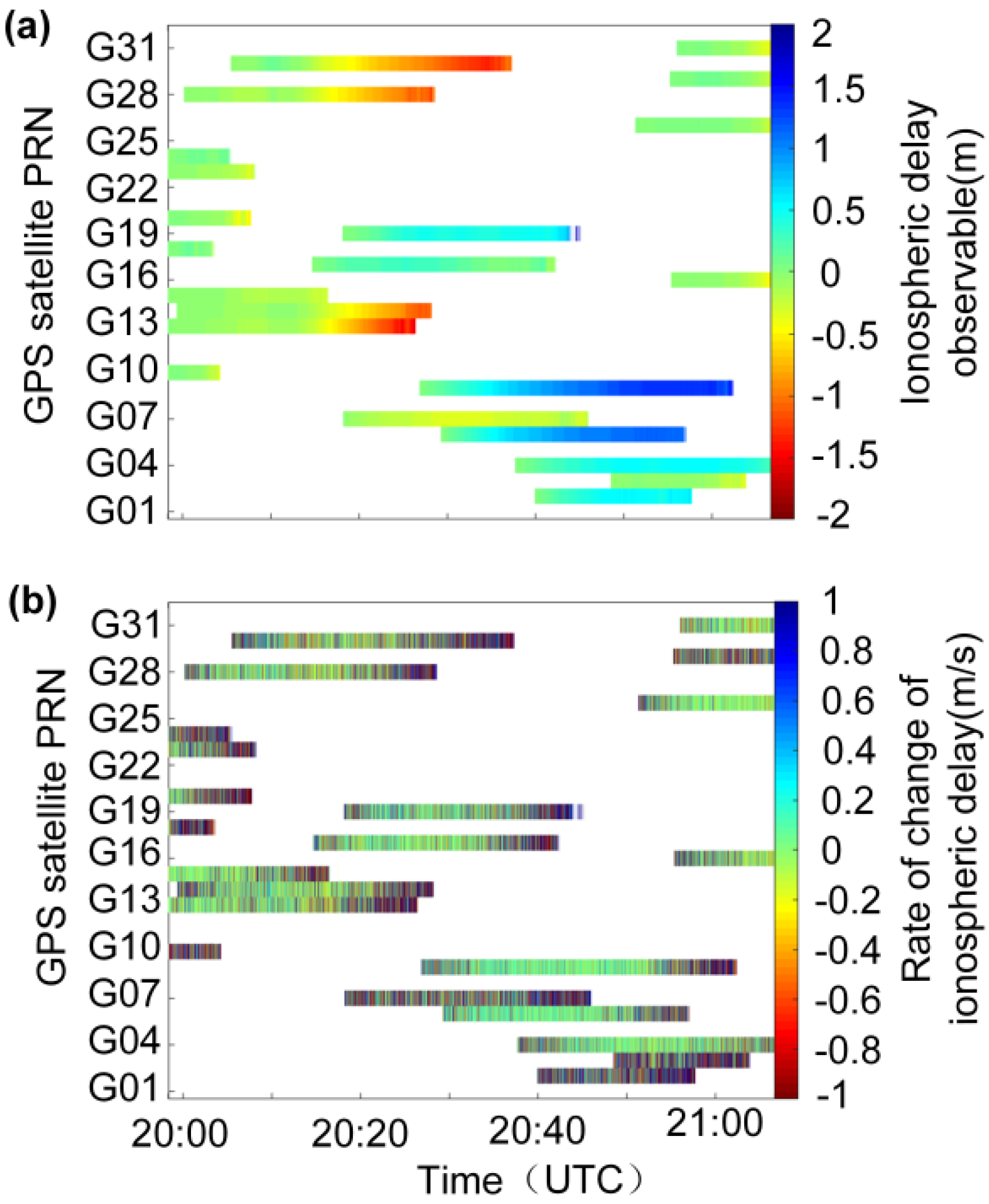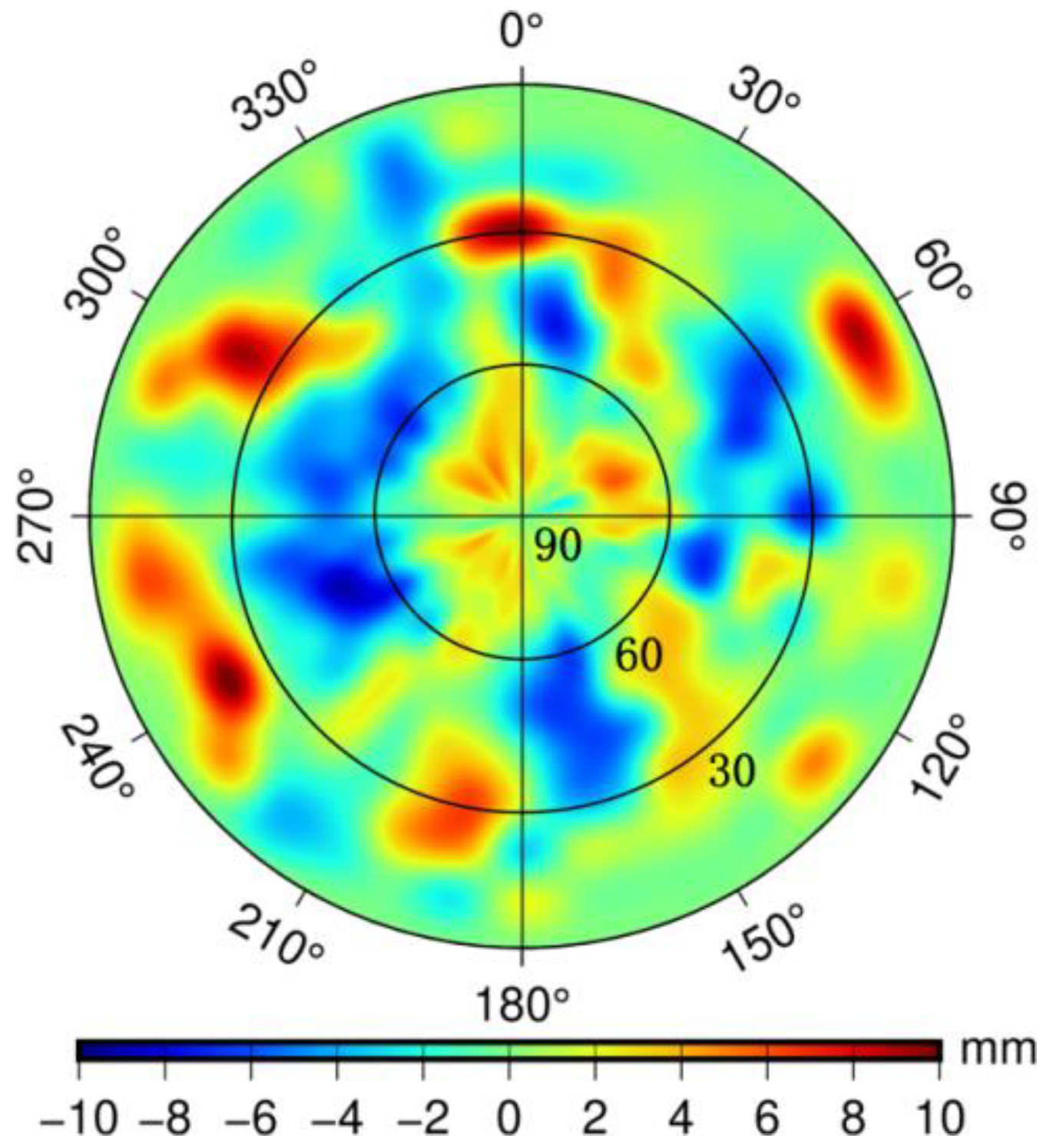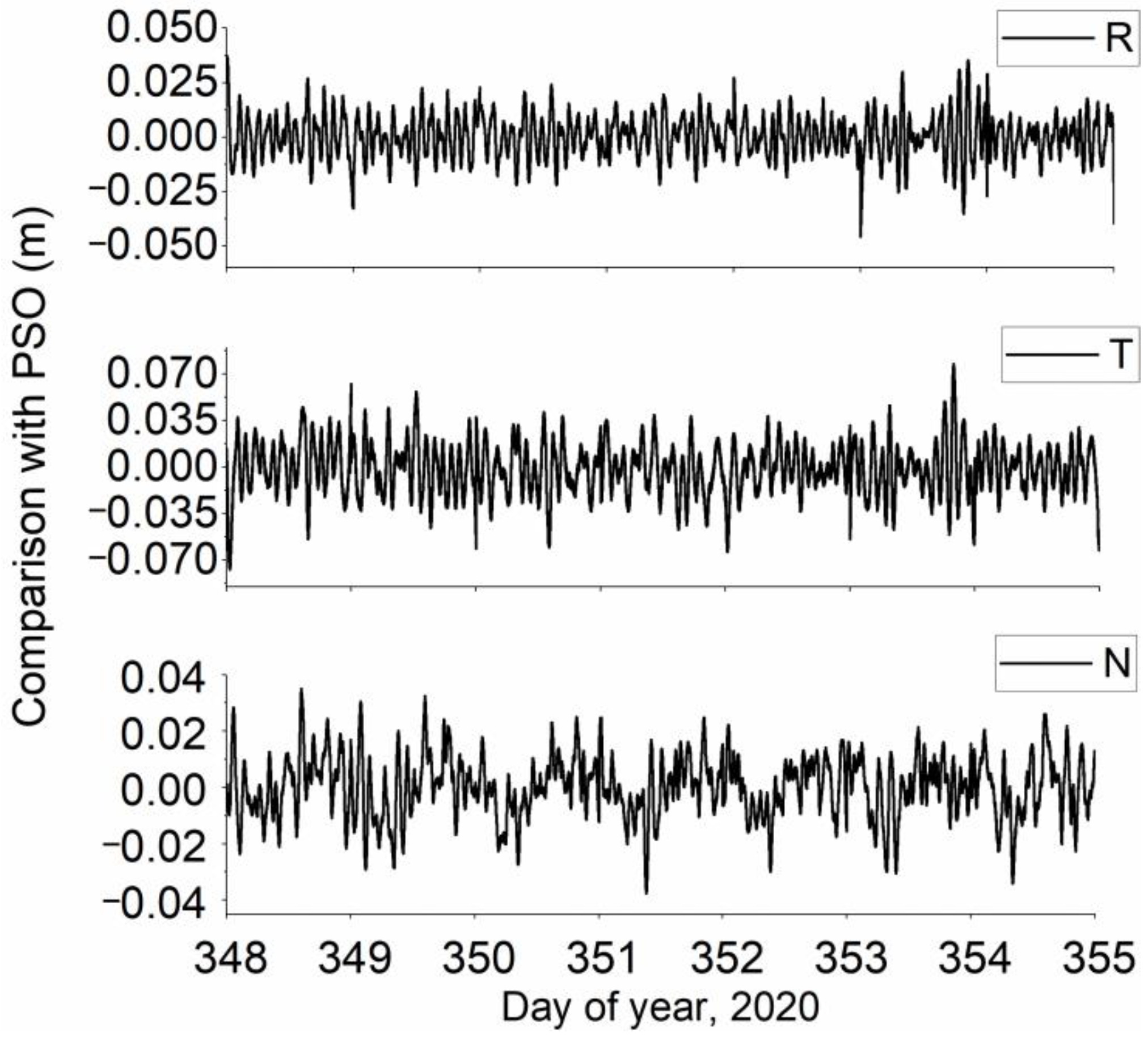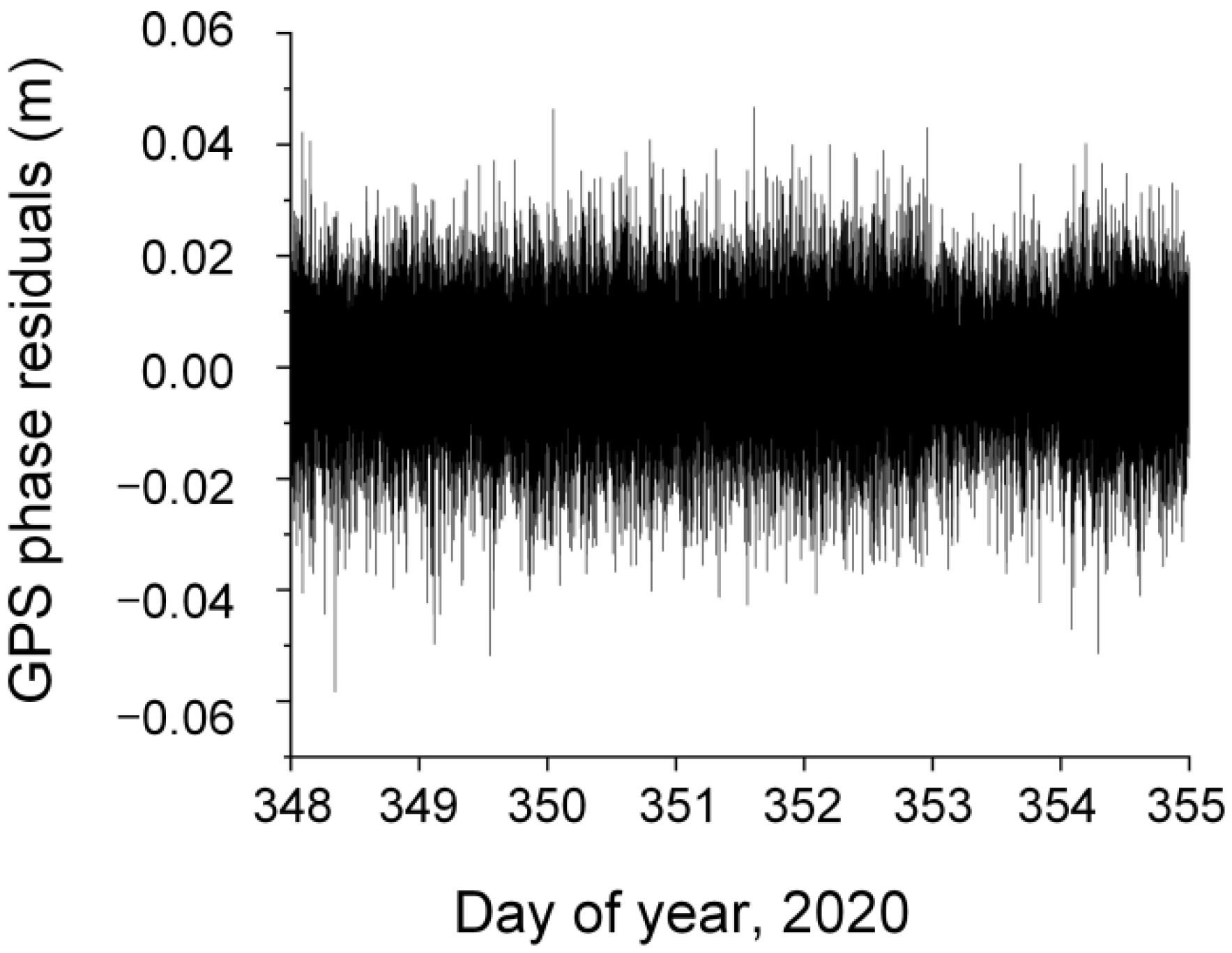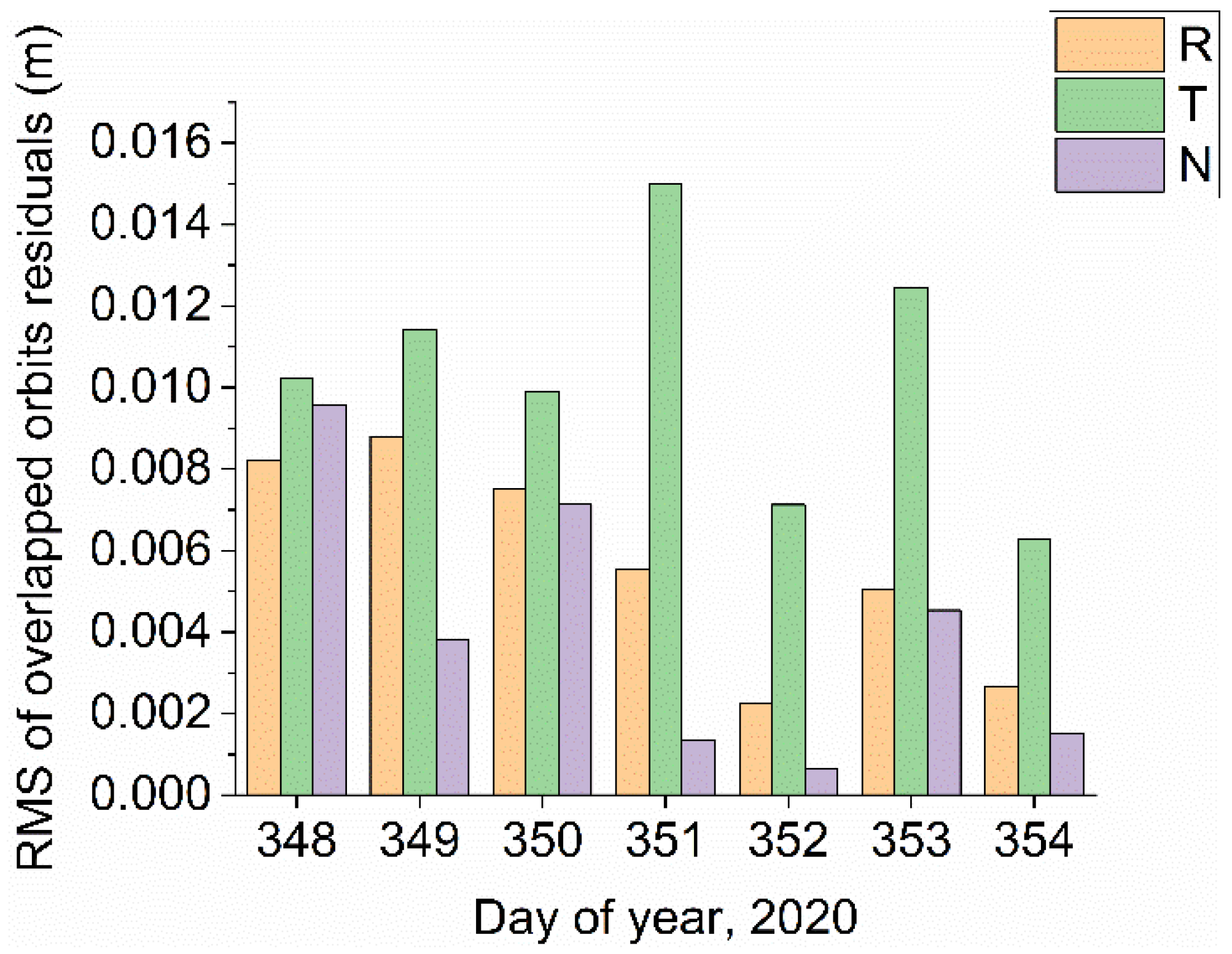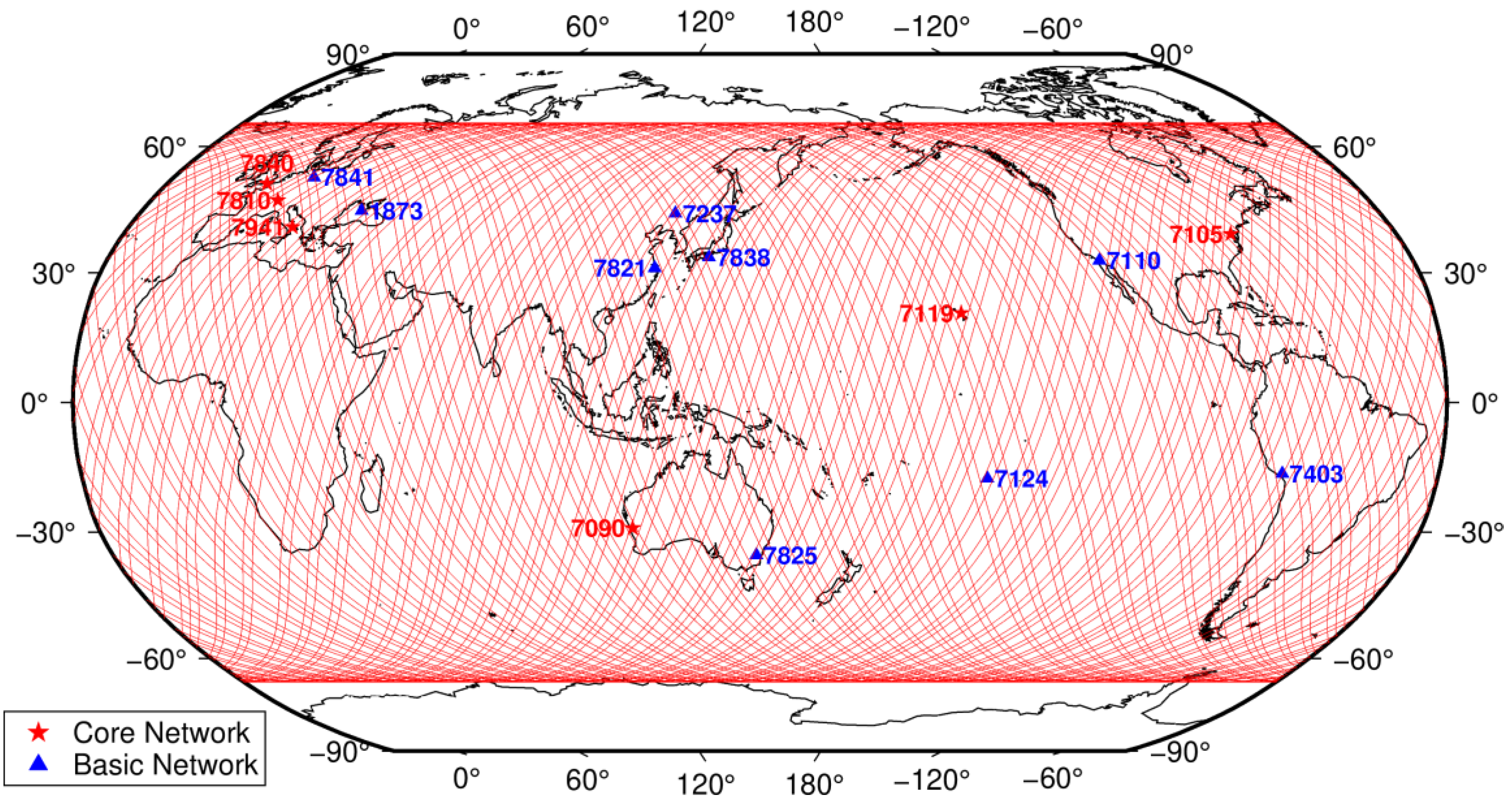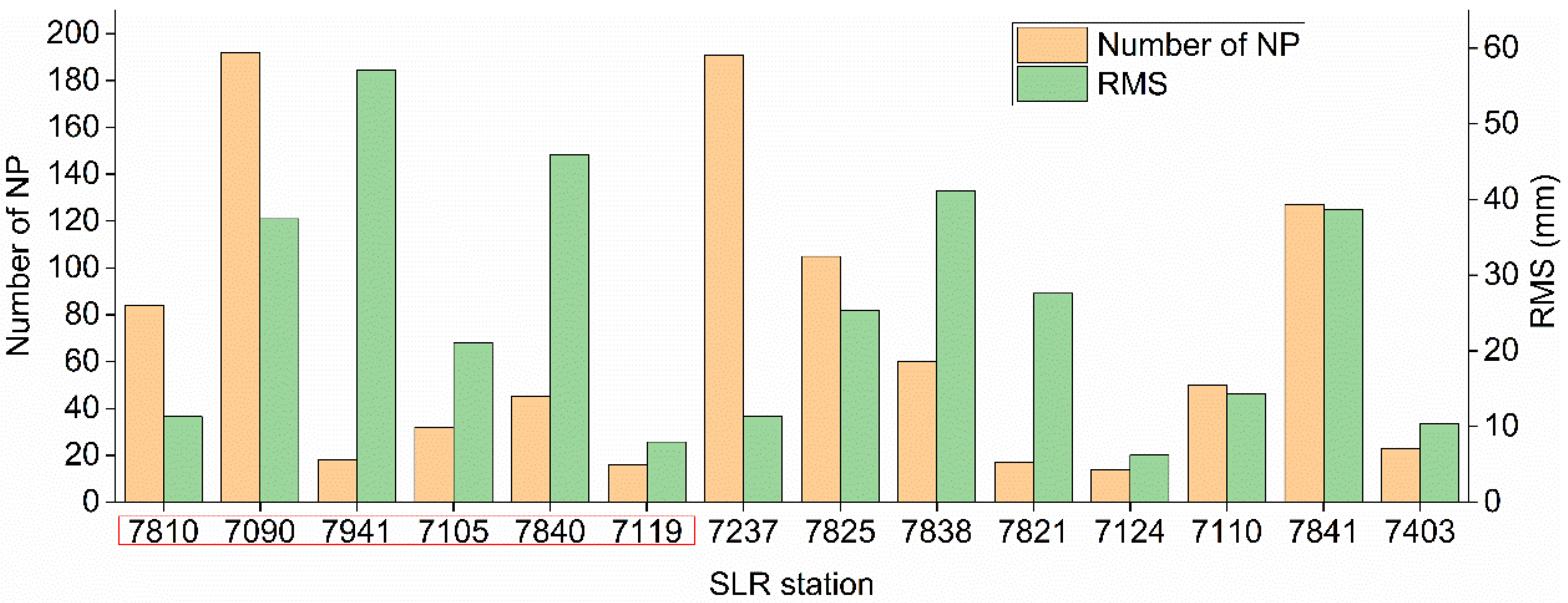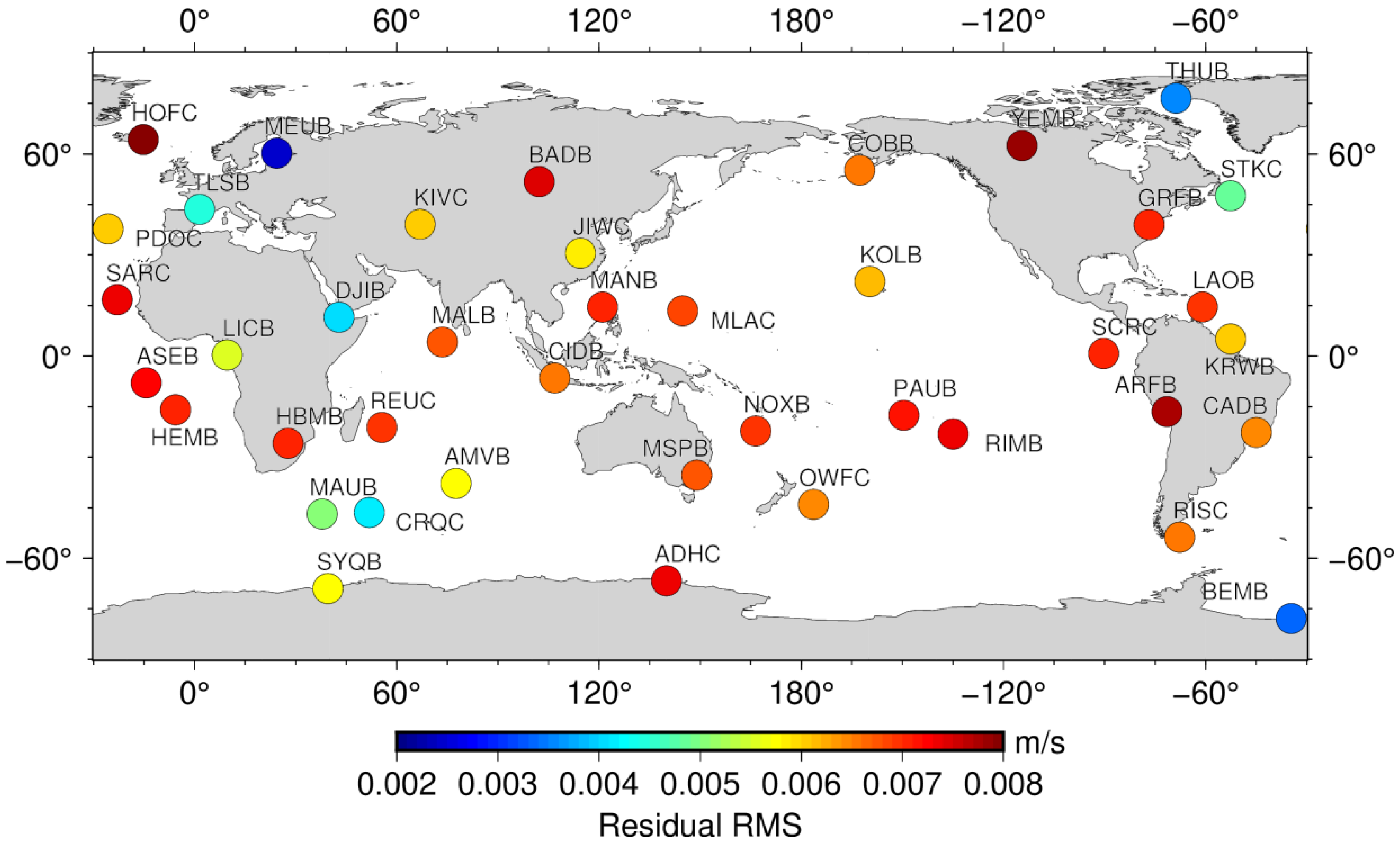1. Introduction
The Haiyang-2C (HY-2C) satellite was successfully launched on 21 September 2020; it was the third satellite launched by China to monitor the dynamic marine environment and the second satellite in the marine dynamic satellite series established as part of China’s national civil space infrastructure [
1]. The main goal is to obtain high-precision and high-resolution real-time observations of the ocean, such as the sea surface height and significant wave height [
2]. The mass of HY-2C is 1677 kg, the Semi major axis is 7328.583 km, the Eccentricity is 0.000012, the average height is 957 km at an inclination of 66°, and the expected lifetime is 3 years. The satellite is connected to HY-2B and HY-2D to form an all-weather, high-frequency, global, marine dynamic environment-monitoring system that covers large and medium scales.
Precise orbit determination (POD) is an important prerequisite for HY-2C to perform altimetry missions, so this satellite requires a high orbit accuracy. To ensure a high-precision orbit, the HY-2C satellite is equipped with three independent payloads, namely, China’s self-developed, satellite-borne, dual-frequency global positioning system (GPS) receiver, named HY2_Receiver [
1], a Doppler orbitography and radiopositioning integrated by satellite (DORIS) receiver named DGXX and a laser reflector array (LRA) for precise orbit determination by Satellite Laser Ranging (SLR) [
3].
The POD of low-Earth-orbit (LEO) satellites using SLR is affected by the number of stations and the meteorological conditions, and the amount of range data is small [
4]. Therefore, SLR can only be used for orbit determination with dynamic methods [
5]. DORIS POD relies solely on the dynamic method. In contrast GPS POD can be based on the dynamic approach as well as reduced-dynamic (RD) and kinematic methods [
6,
7].
Since Bertiger et al. successfully applied the satellite-borne GPS POD technique to TOPEX/Poseidon for the first time, GPS receivers have been employed in combination with many LEO satellites, and the satellite-borne GPS POD technique has become increasingly mature as one of the main ways to determine the precise orbit of LEO satellites [
8]. The dynamic method of POD relies on an accurate dynamic model and must adjust the corresponding model parameters in the orbit determination process; however, this approach is cumbersome and involves complicated dynamics theory [
9]. Consequently, this method is rarely used to determine LEO satellite orbits [
10]. A kinematic method of orbit determination only requires geometric information constructed based on satellite-borne GPS observations, and this information is used to calculate the orbit [
11]; this approach also has high requirements regarding the geometric configuration and data continuity of GPS satellites. The RD method achieves a balance between dynamic modelling and the use of geometric information [
12]. The accuracy of orbit with the RD method is also higher than that based on the dynamic method and the kinematic method [
13,
14].
Satellite-borne GPS POD technology has been successfully applied in conjunction with the CHAMP, GRACE, Jason-1, GOCE, COSMIC and other LEO satellites performing geodetic and oceanographic surveys. These satellites have strict orbit accuracy requirements [
15,
16,
17,
18,
19,
20]. Jäggi et al. have researched the application of pseudorandom pulse parameters in orbit determination and successfully determined the RD orbit of CHAMP [
21]. Guo et al. determined the precise orbit of HY-2A by using satellite-borne GPS observations [
22]. Lin et al. calculate the precise orbit of HY-2A based on GPS data, and the accuracy of the orbit in the radial (R) direction was better than 3 cm [
1]. Gong et al. propose a progressive method to determine the POD of LEO satellites, which leads to an improved orbit accuracy [
23].
The capability of the GPS receiver directly affects the quality of observations and the accuracy of orbit determination. The quality of observations reflects the performance of the onboard GPS receiver. The quality of GPS data can be analysed in terms of the multipath effect, ionospheric delay (IOD), elevation angle and utilization of GPS observations. Montenbruck et al. use the GPS elevation angle and multipath effects to evaluate the performance of the BlackJack receiver carried by the CHAMP satellite [
24]. Hwang et al. have found that the proportion of the kinematic orbits of FORMOSAT-3/COSMIC that can be used for gravity research is less than 30%, and the factors that limit orbit use mainly include multipath effects, cycle slips, IOD and an insufficient number of visible GPS satellites [
25,
26]. Hwang et al. analyse the performance of GPS receivers carried by FORMOSAT/COSMIC and GRACE in orbit determination through multipath, IOD and phase residual methods [
27].
To analyse the performance of the HY2_Receiver and the accuracy of the RD orbit of HY-2C, the quality of GPS observations is analysed, and internal and external validations are performed. A new external method is proposed to validate the accuracy of the RD orbit using onboard DORIS data.
DORIS is a highly accurate tracking system developed by France, with approximately 60 beacons globally for one-way accurate measurements. DORIS contributes to the International Terrestrial Reference Frame (ITRF), and ITRF2014 benefits from improved analysis strategies of the seven contributing International DORIS Service (IDS) analysis centres [
28]. The CNES/CLS analysis centre contributes to the geodetic and geophysical research activity through DORIS data analysis [
29]. In 1990, the SPOT-2 satellite, first equipped with a DORIS receiver, received a centimetre orbit [
30]. DORIS instruments are presently flying aboard SPOT-4 and SPOT-5, Jason-1 and Jason-2, and Envisat. DIODE, developed by Centre National d’Etudes Spatiales (CNES) is successfully applied to Jason-1 [
31]. Mercier et al. utilize DORIS phase and pseudorange data to precisely determine the orbits of Jason-2 [
32]. Zelensky et al. determine the precise orbit of Envisat by using satellite-borne DORIS observations [
33].
Mercier et al. have proposed a POD strategy based on RINEX DORIS 3.0 format with an accuracy of 1~3 cm [
32]. Due to higher frequency, shorter wavelength, and higher measurement accuracy, the accuracy of high-frequency phase data of DORIS data (at frequency 2036.25 MHz) is at the millimetre level. Converting the phase data into a format of average range rate, the nominal accuracy reaches 0.5 mm/s [
34].
Considering that SLR can serve as an external validation method for orbit determination by the GPS POD method, the new method proposed in this paper also innovates the use of onboard DORIS as an external validation method.
The primary aim of this paper is to assess the performance of the HY2_Receiver and the accuracy of HY-2C RD orbits, and to estimate the impact of PCO and PCV models on the orbit of HY-2C simultaneously. The rest of this article is arranged as follows.
Section 2 introduces the HY-2C satellite information, data required for orbit determination and orbit quality assessment, introduces the method and strategy of HY-2C orbit determination, proposes a new external method to assess LEO orbits with onboard DORIS data directly and discusses the reliability of the new external method to validate orbits with onboard DORIS data directly.
Section 3 analyses the quality of GPS data, estimates PCO and PCV models and studies the influence of these models in POD; based on phase residuals, differences between overlapping orbits are determined, comparisons with precise scientific orbits (PSO) are made, independent SLR validation is performed to assess the accuracy of HY-2C RD orbits and an example of HY-2C RD orbits and PSO validations with onboard DORIS data are given. Finally, the conclusions are presented.
4. Conclusions
Based on GPS observations of HY2_Receiver, the quality of the observations is analysed, and the data of the band are more susceptible to changes in elevation than are those of the band. The data utilization results suggest that the HY2_Receiver achieves good performance and can be used in POD missions involving LEO satellites. PCO and PCV models are established, and the satellite orbits obtained by using the PCO and PCV models display better accuracy than those obtained without considering the PCO and PCV models. Compared with PSO, the R-direction residual RMS value is 0.01 m, and the 3D RMS value is 0.025 m. The RMS of the carrier-phase residuals is around 0.008 m. The overlap method is applied to assess the accuracy of orbit determination, and the detailed overlap analysis suggests that the RMS value of the residual of overlapping orbits is 0.006 m in the R direction, 0.011 m in the T direction, and 0.006 m in the N direction. The internal-coincidence accuracy-verification results indicate that the HY-2C satellite orbit determination strategy is reliable; notably, the error term is eliminated during the POD process, and the orbit determination result is relatively stable. SLR range validation is analysed in detail, and the RMS value is better than 0.03 m. The results of SLR range validation suggest that the accuracy of the precise orbit of HY-2C reaches the centimetre level. A newly proposed method is used to check orbits based on space-borne DORIS data directly, and that the accuracy of the range rate of the HY-2C RD orbit reaches 0.0063 m/s.
According to the experimental results, the RD orbit of HY-2C reaches centimetre-level accuracy, and the space-borne GPS receiver HY2_Receiver independently developed in China can be used for LEO POD missions. With the improvement and optimization of the model, the RD method for orbit determination will be increasingly applied to LEO satellites, and the orbit accuracy of satellites will be increased in the future.
